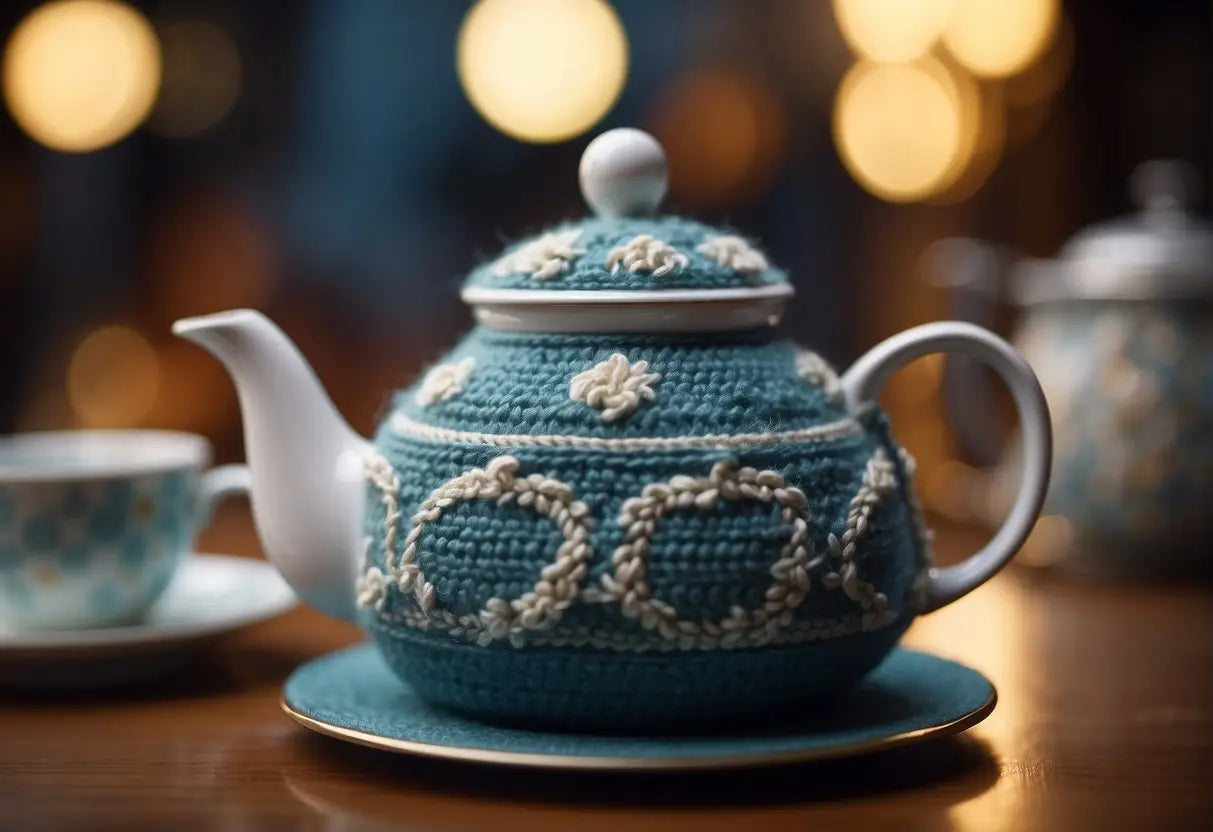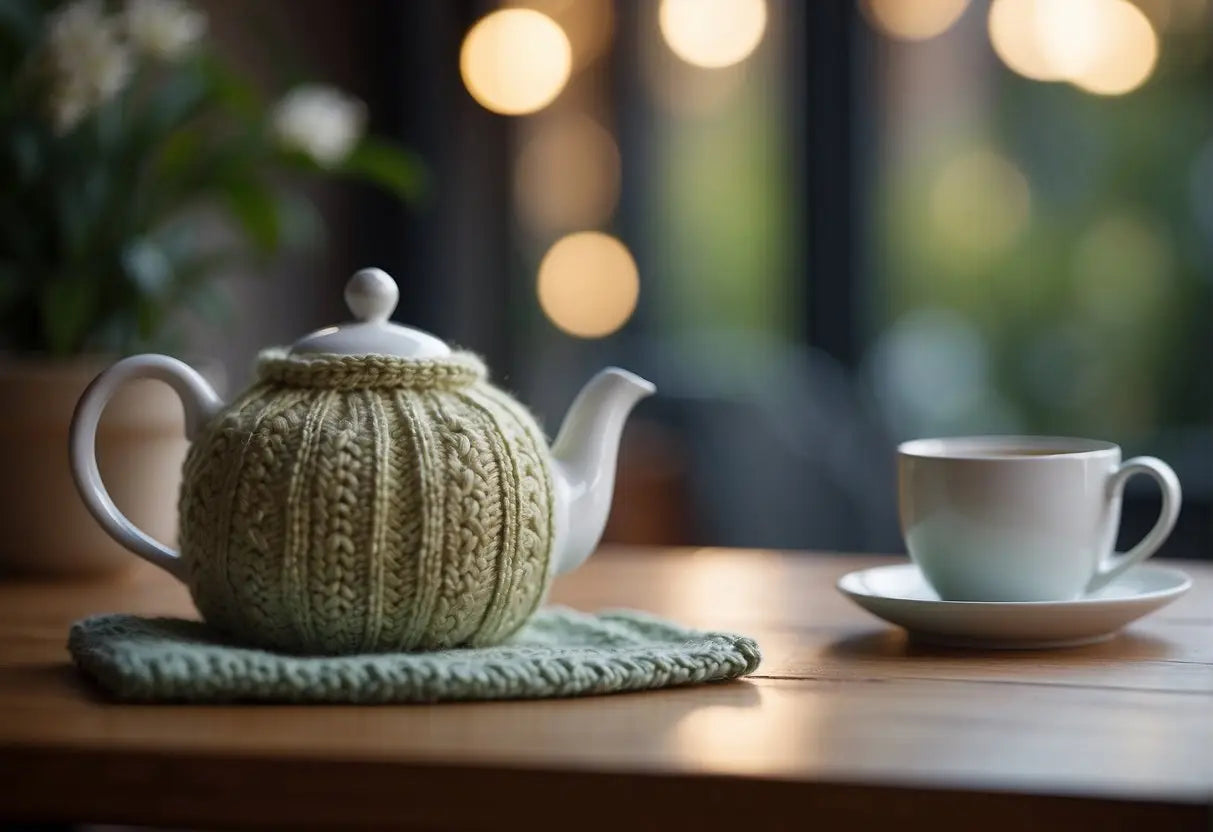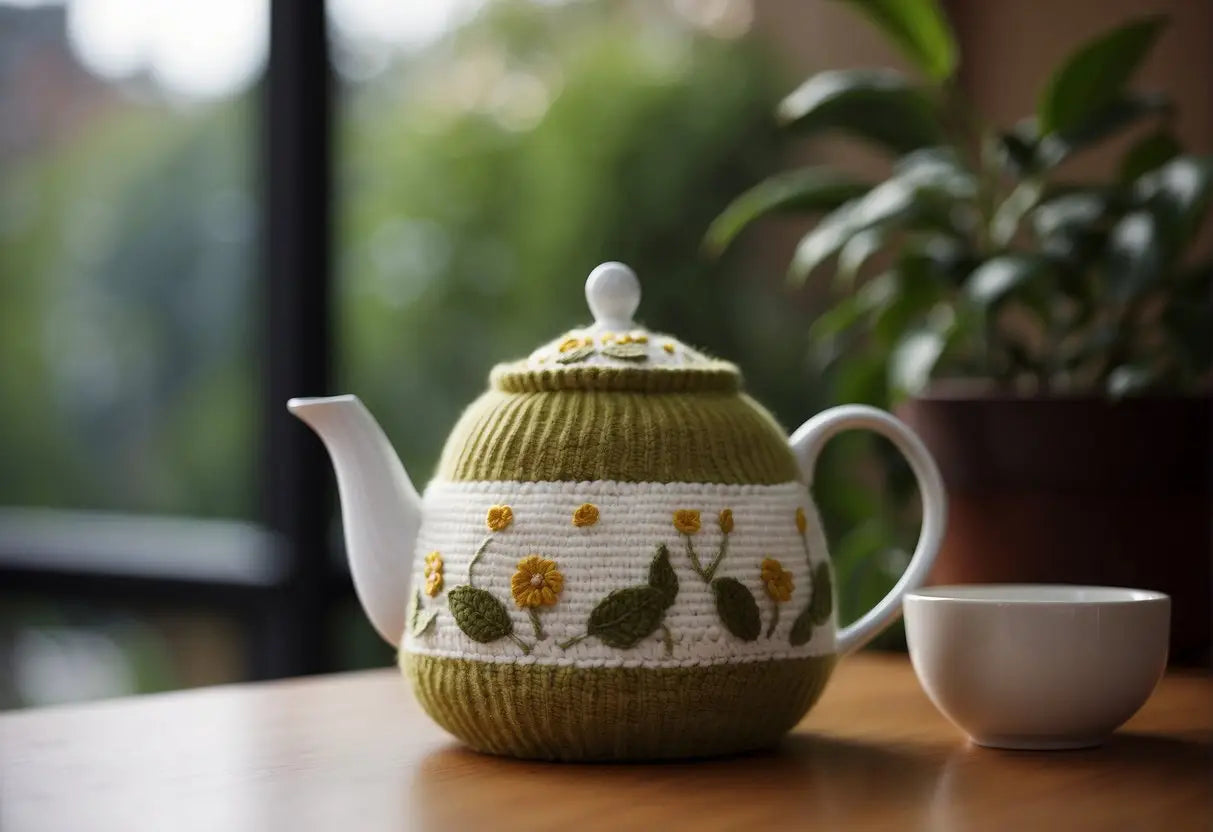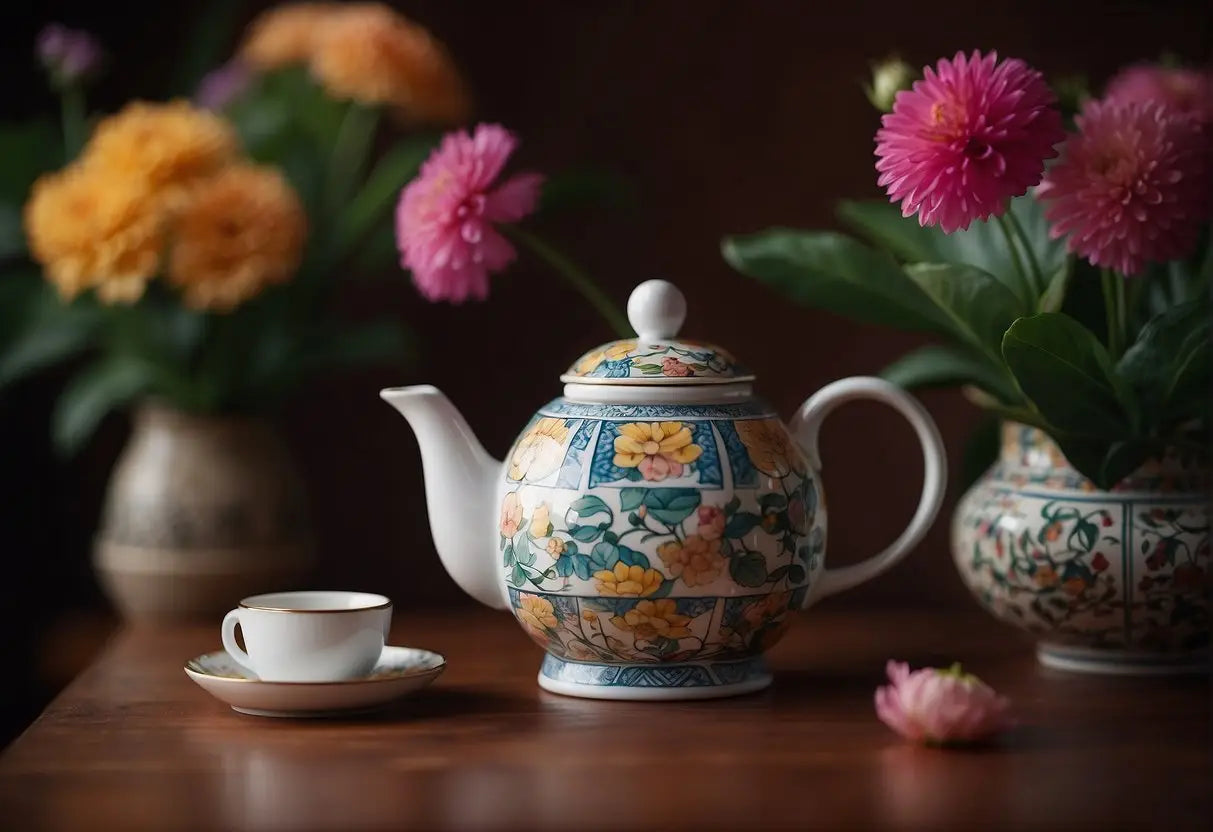What is a Tea Cozy
A tea cozy is a cover for a teapot, traditionally made of fabric or wool and used to keep the tea warm. You'll find that its purpose is straightforward: insulation. It works by creating a barrier around the teapot, trapping the heat inside so that the tea remains hot for a longer period.
When selecting a tea cozy, you should consider the following:
- Size and Fit: It should snugly fit your teapot. A too-tight cozy will be difficult to put on, whereas a loose one won't retain heat effectively.
- Material: Common materials include wool, cotton, and polyester. Wool is excellent for insulation, while cotton is easier to wash.
Here is a simple breakdown of the components:
Bestsellers
| Component | Description |
|---|---|
| Outer Shell | The decorative exterior, often designed with colorful patterns. |
| Insulation Layer | The core that holds the heat, usually made of wool or batting. |
| Lining | The interior fabric, which is soft to prevent scratching the teapot. |
Your cozy can be functional, decorative, or both. They come in various shapes and styles, from simple domes to elaborate animal shapes. When you use it, simply place it over the teapot after brewing. This will maintain the temperature, allowing for a prolonged enjoyment of hot tea.
Care for your tea cozy is minimal. You should follow the care instructions specific to the material, which typically involve hand or machine washing and air drying. Remember to remove the cozy before pouring to prevent spills and stains.
Historical Significance

The tea cozy has played an understated yet symbolic role in the ritual of tea drinking, especially within British culture. It represents not just practicality in keeping the tea warm, but also the artistic expressions of different eras reflected in its design.
Origins of the Tea Cozy
The concept of the tea cozy begins in 19th century Britain, where maintaining the warmth of the tea during long social gatherings was a valued aspect of tea service. With tea being a costly commodity, a fabric cover—the precursor to the tea cozy—was devised to extend the tea's warmth.
Evolution Through History
As time progressed, the tea cozy evolved beyond its practical use to a decorative household item. During the Victorian era, the tea cozy became a canvas for elaborate needlework and styles, reflecting the tastes and artistic skills of the time. By the 20th century, both homemade and manufactured tea cozies showcased a variety of fabrics and patterns, paralleling contemporary fashion and societal changes.
Design and Construction

In creating a tea cozy, the choice of materials and design are essential for functionality and style. Detailed patterns allow for personalization, and with some sewing skills, you can make your own.
Materials Used
Fabrics: Typically, tea cozies are made from insulating materials to keep the tea warm. Popular choices include:
- Cotton
- Wool
- Fleece
Insulation: For increased heat retention, these materials are often used:
- Batting
- Insulated lining, such as Thinsulate™
Fasteners: Depending on the design, you might need:
- Velcro
- Buttons
- Zippers
Patterns and Styles
There is a wide range of patterns and styles, varying from traditional to modern. Common designs include:
Lao Ban Zhang
- Classic Floral Prints: For a traditional look
- Geometric Patterns: To match contemporary aesthetics
- Novelty Designs: Such as animals or holiday themes
- Custom Embroidery: For a personalized touch
DIY Tea Cozy Making
To make your own tea cozy, follow these steps:
- Select a Pattern: Choose a pattern that matches your skill level and style preferences.
- Gather Materials: Purchase your fabric, insulation, and any required fasteners.
- Cut the Fabric: According to the chosen pattern's dimensions.
- Sew the Pieces: Stitch the pieces together, adding the insulation layer.
By following a pattern and using the right materials, you can create a functional and attractive tea cozy that reflects your personal style.
Functional Benefits

A tea cozy serves a practical purpose beyond its decorative appeal. By understanding its functional benefits, you'll appreciate how it contributes to your tea-drinking experience.
Insulation Properties
Insulation: A tea cozy is designed with materials that have thermal insulation properties, such as wool or insulated fabric. These materials trap air within their fibers, which is a poor conductor of heat. This air layer helps to prevent the transfer of heat from the inside of the tea cozy to the outside, keeping the tea pot warm.
-
Materials Commonly Used:
- Wool
- Cotton with insulated lining
- Fleece
-
How It Works:
- Traps warm air around the pot
- Reduces heat loss through conduction
Tea Temperature Maintenance
Consistent Temperature: Maintaining your tea at a desirable temperature is essential for optimal flavor. A tea cozy keeps the tea warmer for a longer period, which is especially useful if you prefer to drink your tea over an extended time rather than consuming it quickly.
-
Temperature Control Benefits:
- Prevents rapid cooling: Your tea stays at a drinkable temperature for longer.
- Enhances flavor stability: Consistent temperatures keep the tea's flavor profile steady.
By using a tea cozy, your tea stays warm, allowing you to enjoy it at your leisure without the need to reheat.
Cultural Impact

The tea cozy has transcended its practical use to become a cultural icon, representing the comfort and quaintness associated with tea time. Its presence in modern culture and as a collectible item demonstrates its significance beyond mere functionality.
Tea Cozy in Modern Culture
In today's culture, you'll find the tea cozy being more than just a practical item; it's a symbol of coziness and a touch of whimsy in a fast-paced world. You may observe it featured in various media, including television and literature, where it often signifies a domestic or historical setting. Designers have even incorporated the tea cozy into fashion, sometimes giving it a pop culture twist with contemporary patterns and themes.
- Television: Regular appearances in British sitcoms, often as a nod to traditional values.
- Literature: Described in scenes to evoke a sense of homeliness or historical era.
- Fashion: Adapted into clothing patterns with artistic licenses that challenge its conventional image.
Tea Cozy Collecting
As a collector, you might be fascinated by the variety and history of tea cozies. They can be found in antique shops and online marketplaces, with some rare finds dating back to the 19th century. Collectors often seek out tea cozies for their:
- Historical value: Vintage pieces that reflect the period's materials and craftsmanship.
- Aesthetic appeal: Diverse range in designs, from hand-knit wool to fine embroidered linen.
- Cultural significance: Representations of different times and places through thematic variations.
| Criteria | Popular Collectible Tea Cozies |
|---|---|
| Vintage | Edwardian and Victorian era cozies |
| Handmade | Unique, artisan-crafted designs |
| Commemorative Cozies | Celebrating events or personalities |
Embracing the tea cozy in your life or your collection is to hold a piece of cultural history that celebrates the charming ritual of tea drinking.
Care and Maintenance

Proper care and maintenance ensure the longevity of your tea cozy. Attention to cleaning and storage will keep it in ideal condition.
Cleaning Methods
Hand Washing: Gently wash your tea cozy in lukewarm water with a mild detergent. Rinse thoroughly and press out excess water without wringing to maintain shape.
Machine Washing: If the label permits, wash on a delicate cycle with mild detergent. Use a laundry bag to protect the cozy from snagging.
Table: Drying Options
| Method | Instructions |
|---|---|
| Air Drying | Lay flat on a clean towel away from direct sunlight. |
| Tumble Drying | Use a low heat setting if the material permits. Remove promptly. |
Aim to clean your tea cozy regularly, depending on usage, to prevent the buildup of stains and odors.
Storage Tips
Proper Placement: Always store your tea cozy in a dry, cool place away from direct sunlight to avoid fading and moisture accumulation that can lead to mold.
Folding and Shape Preservation: If your cozy is structured or has embellishments, store it flat or on a form to maintain its shape. Avoid folding to prevent permanent creasing.
By adhering to these cleaning and storage recommendations, you can keep your tea cozy functional and attractive for each use.
Frequently Asked Questions
In this section, you'll find answers to common questions about tea cozies, clarifying their purpose, gifting potential, terminology, materials, effectiveness, and current usage.
What is the primary purpose of a tea cozy?
The primary purpose of a tea cozy is to insulate a teapot, keeping the tea inside hot for a longer period of time. It acts as a thermal cover and is typically used when tea is served over an extended period, like during long conversations or social gatherings.
Can a tea cozy serve as an appropriate gift?
Yes, a tea cozy can be a thoughtful and appropriate gift, especially for tea enthusiasts or those who appreciate handmade or unique kitchen accessories. It can also be personalized to match the recipient's tastes.
What are the differences between 'cosy' and 'cozy' in the context of tea accessories?
In the context of tea accessories, 'cosy' and 'cozy' are simply variations in spelling. 'Cosy' is commonly used in British English, while 'cozy' is the preferred American English spelling. Both refer to the same insulating cover for teapots.
What types of materials are tea cozies typically made from?
Tea cozies are typically made from fabrics with good insulating properties, such as cotton, wool, or fleece. They may also have a padded lining or be knitted or crocheted to enhance thermal retention.
How effective are tea cozies in keeping tea warm?
Tea cozies are quite effective at keeping tea warm. By providing insulation, they can maintain the temperature of the tea in the pot, usually for up to an hour, depending on the material and design.
Are tea cozies still commonly used today?
Tea cozies continue to be used today, though their prevalence may vary by culture and region. They are popular among tea drinkers who value the tradition and aesthetic of serving tea, as well as those who wish to keep their tea warm without reheating.
← Older post Newer post →











